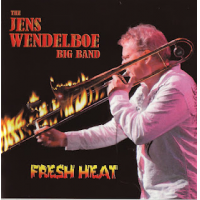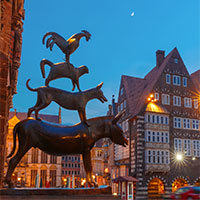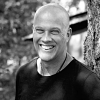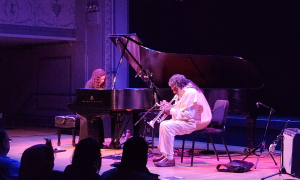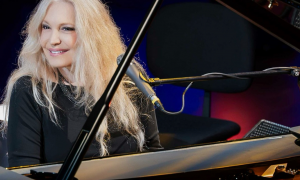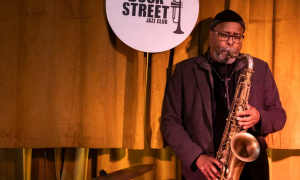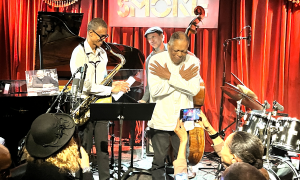Home » Jazz Articles » Live Review » Jazzahead! 2012
Jazzahead! 2012
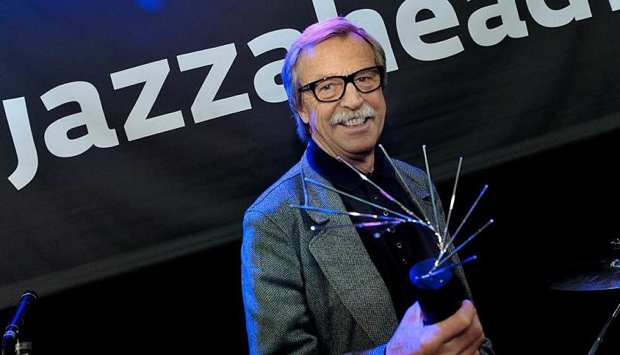
Bremen, Germany
April 19-22, 2012
While folks around the world debate the future of jazz—and, for that matter, what exactly jazz is and even what it should be called—an annual trade show in Bremen, Germany, now in its fifth year, has managed to demonstrate that jazz as a brand may be facing challenges like everything else, but is far from approaching its death bed. Jazzahead! also makes clear that the future of jazz is absolutely and undeniably predicated on the tireless efforts of a surprisingly connected (and growing) community of passionate people, who travel each year from points around the globe for a few days of showcase performances, meetings, educational streams...and just plain hanging. From Penang to Portland, Montreal to Molde, Brooklyn to Bologne, Reykjavik to Rotterdam, Tallinn to Tampere and Kuala Lampur to Köln, musicians, record label reps, festival promoters, booking agents, artist managers, writers, photographers—and people who just want an opportunity to catch as many as fifty acts, selected by an international jury each year, strut their stuff for a brief but important thirty minutes—have made Jazzahead! an annual cannot-miss event whose incremental growth will surprise those who think that the end of jazz is nigh.
If anything, 30% growth in 2011 and a projected growth for 2012 of a whopping 35% would suggest that Jazzahead! may soon need to consider extending its core event by another day and look for a larger night-time showcase venue than Schlachthof, the converted slaughterhouse where getting in is becoming increasingly difficult and—unless you're prepared to line up two hours early (sacrificing valuable meeting time)—in which finding an actual seat is next to impossible. With so many people to see during the daytime, and an overwhelming number of showcase acts beginning at two in the afternoon and running well past midnight each evening, it's an exciting place to be, but one where there's a constant sense of trying to keep up—or, even worse, catch up. Two floors in the Exhibition Centre Bremen sport about 100 booths—occupied by labels like ECM, ACT, Pirouet , Edition Records, Challenge, Effendi, Hubro, Rune Grammofon, NORCD and Enja; larger booths which act as focal points for a variety of interests for countries ranging from Norway, Denmark, Canada and Iceland to The Netherlands, Sweden, The UK and Brazil; festivals including WartaJazz from the Far East, ELBJazz from closer to home in Hamburg, and Skopjejazz in Macedonia; magazines including Germany's Jazzthetik, Norway's Jazznytt; and artists ranging from pianist Sunna Gunnlaugs and trumpeter Gunhild Seim and saxophonist Yuri Honing to Kairos 4tet and Levantasy.
And then there are the people who come to Jazzahead! to just "float"—media folks like Jazzwise's Jon Newey, Jazznytt's Jan Granlie, and freelancers like Luca Vitali, Madli-Liis Parts, Henning Bolte, Christoph Geise and Karsten Muetzelfeldt; festival representatives including Palatia Jazz's Hagen Daten, Earshot Jazz's John Gilbreath, Molde Jazz's Jan Ole Otnes, Vancouver Jazz Festival's Ken Pickering and Penang Jazz Festival's Paul Augustin; and management/publicity folks like Nadja Von Massow, Antje Hubner, Burkhard Hopper, Don Lucoff and Matt Merewitz. What's more surprising than the sheer number of people who attend Jazzahead! is how many people know each other—the biggest challenge, next to accomplishing everything you'd planned for going to Jazzahead! is actually leaving; unless hurrying away under cover of darkness, most Jazzahead! regulars need a good 60-90 minutes to say goodbye to everyone, before actually being able to exit the venue(s).
That's not to suggest the road ahead for jazz is an easy one, but with the number of international festivals continuing to increase, and the virtually untrackable volume of new releases coming out each and every month from artists known and unknown, it's clear that few may be getting rich in jazz, but plenty are dedicating their lives to it, whether they're artists, journalists, publicists or festival promoters. Jazzahead! is the place to be to find out about the European jazz scene, to be sure, but in the last couple years the event has broadened its purview to include showcase performances from artists farther afield, with this year's "Overseas Night" featuring Canada's François Bourassa Quartet, American saxophonist/clarinetist Oran Etkin, Brazil's Trio Corrente, and the return of vocal artist Vinx, who burst onto the scene in the 1980s, opening for artists like Sting, but who later seemed to be MIA.
And then there are the awards. This year, Siggi Loch—founder and primary producer for Germany's ACT Music+Vision label (celebrating its 20th anniversary this year, though Loch's involvement in the industry has now eclipsed the half century mark)—was the recipient of the ŠKODA Award, while the European Jazz Network, now celebrating its silver anniversary, inaugurated its first Award for Adventurous Programming. Few could argue its choice of Ireland's 12 Points Festival which, thanks to Founder/Artistic Director Gerry Godley, has focused on bringing one dozen cutting edge, up-and-coming European acts to public attention each year since its inception in 2007.
All in all, Jazzahead! 2012 was a smashing success, even with the problems that are beginning to show as a result of its rapid growth. And while it was impossible to catch anywhere near all the showcase performances presented, those caught—ranging from Spain's Benavent-Di Geraldo-Pardo and England's Kit Downes Group and incendiary Marius Neset Golden Xplosion, to Norway's sublime singer Solveig Slettahjell and outrageous Trondheim Jazz Orchestra, and the ACT-sponsored feature for saxophonist/clarinetist Tim Garland, pianist Gwilym Simcock and percussionist Asaf Sirkis—demonstrated the breadth and depth of an international jazz scene that may be dealing with the same fundamental industry shifts that are affecting everyone in the arts, but remains vibrant and strong, evolutionary and revolutionary.
Chapter Index
April 19: Spanish Night
April 20: ACT Presents: Jens Thomas and Simcock Garland Sirkis
April 20: Omer Klein
April 20: Vinx and Oran Etkin Kelenia
April 21: Trondheim Jazz Orchestra and Kit Downes Group
April 21: Marius Neset Golden Xplosion
April 21: Solveig Slettahjell with Morten Qvenild
April 19: Spanish Night
Jazzahead! 2012 kicked off its first evening of showcases with a themed evening dedicated to musicians from Spain. Early in the evening, drummer Guillermo McGill transcribed the music of Ramón Montoya (considered by some to be the father of flamenco guitar) and saxophonist Fernando Vilches, who released three albums together in the 1920s. With Dani de Morón handling guitar duties, and bassist Manuel Posadas filling the bass chair, it was saxophonist Julian Arguelles who brought the music to life—and into the 21st century. Despite being born and raised in England, Argüelles' familial background includes some Latin blood and, between his 2011 performance with pianist Mário Laginha at the 2011 Jazz no Parque in Portugal and his stellar performance here, it's clear there's no escaping at least some of his roots, even as he applied a more sophisticated vernacular to music nearly a century old.

Unfortunately, saxophonist José Luis Gutiérrez and his quartet didn't fare quite so well, despite a promising start. Clearly imbued with an absurd sense of humor, Gutiérrez came onstage with his alto and soprano saxophones, but also with a bevy of other strange implements and found objects. Beginning the performance with what looked like a microphone stand that had a series of rings on the bar, he created a jangling percussive intro that seemed intriguing until the group entered, rendering it largely superfluous. And that was the modus operandi for the rest of the quartet's short set, despite everyone clearly being capable. Guitarist Luis Giménez was the least dominant of the bunch, capable but lacking flair. Bassist Marco Niemietz and drummer Tommy Cagginani were more impressive, muscularly navigating Gutiérrez's sometimes idiosyncratic music, often filled with stop/start accents, with ease. As a saxophonist, Gutiérrez was also impressive, running the range of both instruments and employing a number of extended techniques to great effect.
While at least some of the crowd enjoyed Gutiérrez's wacky sense of humor, it ultimately became tiresome, however, when a set-closing duo between Cagginani and Gutiérrez found the drummer introducing all kinds of found objects onto the mix, ranging from small, battery-driven devices to keep his cymbals ringing to squeaky toys, garbage pail lids and more. Comedy is about timing and knowing when to quit; unfortunately, Gutiérrez and his group went well past that time, and it's a shame, as it was a group with some promise. Nothing wrong with humor in music, but a little more restraint might have gone a long way.
While the looming effects of jetlag meant being unable to stay for the entire final show of the evening, it was well worth waiting for even a few minutes of Benavent-Di Geraldo-Pardo, which featured two musicians best-known internationally for their collaborations with Chick Corea, most recently on 2005's Rhumba Flamenco: Live in Europe (Chick Corea Productions) and the pianist's ambitious The Ultimate Adventure (Stretch, 2006), but here performing their own music from Sin Precedentes (Nuevos Medios, 2009).

Bassist Carles Benavent is a completely different kind of electric player—capable of anchoring the pulse with drummer Tino Di Geraldo but, coming from the flamenco tradition, also imbuing the music with a strong melodic foil for Jorge Pardo, who opened on flute but had saxophones on hand for the rest of the set. Together, this trio of fifty-somethings played with the energy and commitment of folks half their age, but with the experience and comfortable ease of players who've been around the block more than a few times. The music was, indeed, flamenco fusion, but whereas McGill was often a little too literal and Gutiérrez way too over-the-top, Benavent-Di Geraldo-Pardo was the perfect combination of passion, power and lyricism.
April 20: ACT Presents: Jens Thomas and Simcock Garland Sirkis
Following ACT label head/producer Siggi Loch's receipt of the ŠKODA Award, the label presented two showcases that couldn't have been more different. First up was German pianist/singer Jens Thomas and his Speed of Grace (2012) project, which curiously turned the balls-to-the-wall music of classic rock group AC/DC into singer/songwriter grist. Like the recording, Thomas was accompanied only by up-and-coming Finnish trumpeter Verneri Pohjola, but unlike the disc—on which he also employs Fender Rhodes, Wurlitzer, harmonium and shaman drum—Thomas' performance was almost entirely acoustic. Almost, because for the set closer, he brought out an old metronome and, setting it to tempo, quipped "much nicer than beep, beep, beep."
Entering the room from the rear, Thomas slowly made his way to the stage singing in a high, powerful falsetto, ultimately seated at the piano and moving into a soft medley of "Highway to Hell" and "It's a Long Way to the Top." AC/DC never sounded this melancholy. Pohjola came onstage for "The Jack," his long, sinewy lines providing counterpoint to Thomas' blues-inflected playing, though it was when Thomas returned to falsetto in the set's encore—the only non-AC/DC tune, the pianist's own "Keep It Down Boy"—that the two voices merged, creating something quite special. The idea of adapting AC/DC as singer/songwriter material may sound like shtick, but Thomas' impressionistic approach was clearly all his own.

But it was ACT's second showcase that would prove to be not just a highlight of their afternoon, or the day, but of the entire Jazzahead! 2012. British saxophonist Tim Garland first came together with pianist Gwilym Simcock in Acoustic Triangle, the all-acoustic group with bassist Malcolm Creese. As unique as that trio was (there's not been a new release since 2008's Audio-B recording, 3 Dimensions), it was when Garland recruited Simcock and Israeli expat percussionist Asaf Sirkis for a bass-less trio that was at the core of his more ambitious If the Sea Replied (Sirocci, 2005)—which also featured a string ensemble, Creese and ex-Lammas guitarist Don Paterson—that he'd found a new group to rival his extant Storms/Nocturnes Trio, with pianist Geoffrey Keezer and vibraphonist Joe Locke.
Two very different groups, of course; but while Storms/Nocturnes has always been a collaborative group compositionally, Garland's trio with Simcock and Sirkis remained largely his own project through the release of the similarly expansive Libra (Globalmix, 2009) until more recently, with the release of Lighthouse (ACT, 2012), which represents a number of firsts. The album was not released under Garland's name alone, with the banner of "Simcock Garland Sirkis" reflecting the more egalitarian nature of a group that has evolved considerably since If the Sea Replied. Everyone in the group is now a leader in his own right, and with Lighthouse, Garland also shares compositional duties, albeit mostly with Simcock.

Lighthouse is also the first recording to feature the trio without any additional augmentation, and if its brief showcase was any indication, this is a trio that needs nothing more than its three core members. Opening with Garland's Spanish-tinged "Bajo del Sol"—recorded by the trio on Libra but first heard during Garland's tenure with drummer Bill Bruford's Earthworks on Random Acts of Happiness (Summerfold, 2004) andl, later, on the live Earthworks Underground Orchestra (Summerfold, 2006)—Garland opened the set with a bass clarinet solo that set a high bar for the rest of the set.
A bar that was met, and raised by Simcock, Sirkis and Garland himself, as he moved to soprano saxophone for his mid-song solo on "Bajo" following Simcock, whose star continues to rise for his own recordings, including the impressive solo effort, Good Days At Schloss Elmau (ACT, 2011), and rightfully so. How these guys managed this kind of heat in a brightly lit room in the middle of the afternoon is anyone's guess, but it's clear that this is a trio that can turn it on at any time of the day or night...and at the drop of a hat. Garland's "The Wind on the Water" followed, a gentler ballad but still possessing the under-the-hood complexities that give this trio such a rich sound and an undercurrent of tension that's in a constant state of flux, between Simcock's contrapuntal accompaniment, Garland's broad-reaching lyricism and Sirkis' absolutely perfect pulse, delivered on a curious hybrid of a drum kit that included plenty of hand drums in addition to the more conventional cymbals and bass drum.
Sirkis also plays a mean hang—that curious tuned percussion instrument that looks like an inverted wok, designed by two Swiss instrument makers to be used for meditation purposes, but popularized by another British group, Portico Quartet, on a series of cutting-edge albums including the recent Portico Quartet (Real World, 2012). But whereas Portico's use of the hang is more textural, Sirkis' own career as a leader and composer on albums including 2008's The Monk (SAM) means his approach to the instrument is more fully integrated—and melodically distinct. His a capella opening to Simcock's vibrant "King Barolo" was yet another highlight of a set filled with them, while his seamless move back to sticks and pulse-driven accompaniment, for a tenor solo from Garland that built to a dizzying peak, only served to demonstrate his unfailing ability to be in the right place at absolutely the right time.

An unidentified tune where Garland began by blowing his tenor into Simcock's piano, setting off a cloud of sympathetic string vibrations that proved it's possible to think outside the box sonically without the use of electronics, led to Simcock's closer, the fast-paced, occasionally odd-metered but unrelentingly grooving "Space Junk." While by no means an imitator, Garland's rich vernacular, potent tone and personal ideation make him as much a torch-bearer for the late Michael Brecker as Chris Potter is in the United States, and deserving of the same popular acclaim. Simcock, since literally leaping onto the scene just a few short years ago, may well be Britain's youthful answer to John Taylor, though his classical background lends him a different perspective and way into the music. Sirkis, with his unorthodox kit and a compositional background that gives him a broader perspective than many percussionists, is a veritable force of nature, albeit one as capable of subtlety and nuance as he is overt displays of virtuosity. Together, Simcock, Garland and Sirkis embody the best qualities of virtuosity, lyricism and empathic interaction, making Lighthouse already one of the year's best releases and their performance at Jazzahead! 2012 a brief teaser for what they must be like in a proper concert hall with a complete program.
April 20: Omer Klein
In a field crowded with pianists, any newcomer has a considerable challenge of getting heard, much less critical attention, but in the few years since his Fresh Sound debut, Duet (2007), with bassist Haggai Cohen, Omer Avital has managed to get the attention of Radical Jewish Culture mogul John Zorn and the upstart Smalls Records label—the imprint of the New York club that, since its revival in 2004 and, in particular, with pianist Spike Wilner's involvement in 2007, has become one of the city's better go-to venues. With four releases as a leader to date, most recently Rockets on the Balcony (Tzadik, 2010), the barely 30 year-old pianist has been garnering increased attention and numerous awards.
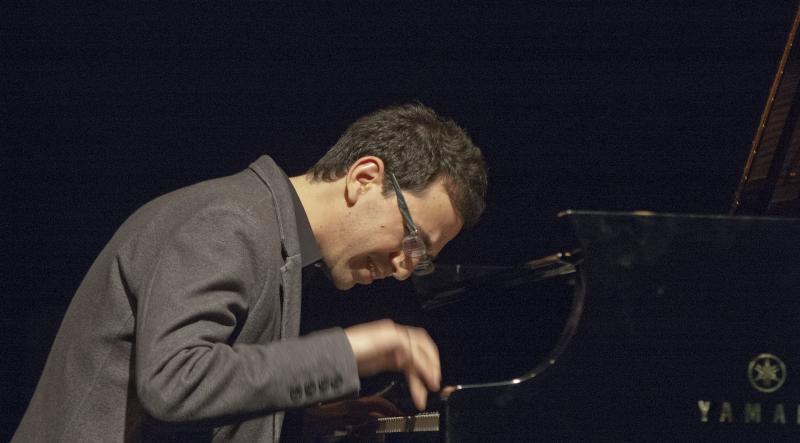
For his solo piano showcase at Jazzahead!, the Israeli-born pianist was joined by a surprise guest. Percussionist/drummer Ziv Ravitz, Klein's longtime trio mate, was there to perform with another pianist, Florian Weber, as part of the German Jazz Expo. When Klein heard he'd be there, he invited Ravitz to sit in on a couple tunes. Klein opened the set solo, however, with a song recently recorded for a new album that's currently being shopped for a label. While it was clearly based on a predefined structure, as the piece progressed and opened up so, too, did Klein, leaning more heavily into the piano with a style that was clearly informed by Keith Jarrett, but with more carefully reserved virtuosity.
The two tunes that featured Ravitz, including "3/4 Mantra" from Introducing Omer Klein (Smalls, 2008), were understandably more intrinsically propulsive. Ravitz played his cajón with a kind of reckless abandon, empathically connected to Klein, who pushed-and-pulled his longtime friend with the kind of comfortable ease that only comes from sharing plenty of time together onstage and off. While Klein's solo performance would have been impressive on its own—"Something About Love," from the new recording, was a particularly moving ballad that demonstrated the pianist's ability to say plenty with very little—the surprise addition of a longtime band mate gave those in attendance an opportunity hear two facets of this talented up-and-comer.
April 20: Vinx and Oran Etkin Kelenia
After a brief dinner break, wandering back to Schlachthof for Overseas Night, it was almost impossible to find a way in, so crowded were the grounds and so over-packed was the actual concert hall. With Jazzahead!'s growth clearly outpacing the capacity of this attractive venue, this year was marred by it being almost impossible for media, invited to cover the event, to find standing room with sight lines to the stage, let alone a seat in order to take notes. After standing near the top of the hall for the end of Vinx's set—a few years since his "big break" with Sting, but still as powerful and innovative as ever, as he looks to kick start his career again with a recent live recording, a film in the works (Memoirs of a Hip 'Ole Black Man, which may include footage from his Jazzahead! performance), and digital download reissues of his early recordings—it appeared that the only way to shoot and take notes was to lean against the stage, right in front of the massive PA system.
Fortunately, saxophonist/clarinetist Oran Etkin and his Kelenia group weren't so loud as to make that an uncomfortable hearing riskBorn in Israel but living in the United States since he was four years-old, Etkin has been refining a remarkable educational program for bringing jazz to young ears. He calls this method Timbalooloo and his classes, which are spreading to locations around the United States and attended by children of well-known names like Harvey Keitel, Naomi Watts and Liev Shreiber, Ken Burns, and Edie Falco, use the seemingly simple premise that instruments "speak," in order to expose children as young as three years old to music that too many adults mistakenly consider to be too sophisticated for infant ears. Wake Up Clarinet! (Timbaloolook, 2010) is a recording, however, that appeals to all ages.

As does Kalenia (Motéma, 2009), Erkin's "adult" debut whose genesis stemmed from meeting balaphonist Balla Kouyate literally the day after he'd arrived in New York from Mali. Kelenia also features percussionist/singer Yeye Kante and, for the Jazzahead! date, bassist Stephane Kerecki, and brings music from Africa and the Middle East into the jazz sphere. An easygoing yet charismatic performer, Etkin may have owned the stage when he was soloing—his saxophone and clarinet work impressive, but his bass clarinet playing that was most memorable—but he shared the stage democratically with his band mates, often moving to stage left to interact with Kante while leaving plenty of solo space for Kouyatye, whose website cites him as being "among the greatest balafon players in the world today," and for good reason. With two balafons lined up side-by-side to allow him access to a chromatic scale, Kouyate extended the pentatonic nature of this calabash-resonated frame, wooden-keyed instrument into the more sophisticated structure of jazz.
Grooves abounded, as Kelenia married Third World ethnicity with First World harmonies; none other than reed and woodwind legend Yusef Lateef—Etkin's mentor from an early age along with saxophonist Dave Liebman—has spoken in praise of this veritable early-thirties cottage industry, whose work in education may ultimately eclipse his performance work, if only because of its importance in bringing jazz to a young audience. But, based on his performance with Kelenia, Etkin is clearly not someone to miss, and with two tracks on the 2012 Grammy Award-winning All About Bullies, Big and Small (Independent, 2011) and a 2011 Grammy nomination for the Health Food For Thought (Independent, 2010) compilation with Russell Simmons, Julian Lennon and Moby, Etkin's star is clearly on the ascension, so this may be one of the last times to catch him in such an intimate context.
April 21: Trondheim Jazz Orchestra and Kit Downes Group
As part of Jazzhead! 2012's day-long European Jazz Meeting, focusing on up-and-coming Euro acts, Norway's Trondheim Jazz Orchestra seemed like an odd choice. TJO has, after all, been around with a revolving door of personnel for some time. Coming from the renowned Trondheim Conservatory, the TJO has provided an opportunity for a number of important Norwegians to cut their teeth. In addition to collaborations like this year's stunning The Death Defying Unicorn (Rune Grammofon, 2012), where TJO worked with Motorpsycho and Supersilent keyboardist Ståle Storløkken for a progressive rock classic, the orchestra regularly records albums focusing on its various alumni, including saxophonist Eirik Hegdal's Triads and More (MNJ, 2011) and Migrations (MJN, 2011), with trombonist Oyvind Brække (also of The Source, with saxophonist Trygve Seim).

Both Heigdal and Brække were on-hand for TJO's Jazzahead! debut, along with younger members including relentlessly hard-working bassist Ole Morten Vågan, of Mellow Motif and The Deciders; violinist Ola Kvernberg, whose Liarbird (Jazzland, 2011) was one of last year's best; and trumpeter Eivind Lønning, who's been gaining some international visibility as a member of pianist Christian Wallumrod's ensemble on ECM recordings including Fabula Suite Lugano (2010).
A Norwegian super group then, perhaps, with Swedish pianist Maria Kannegaard, whose trio with Vågan and drummer Thomas Strønen was last heard on Camel Walk (Jazzland, 2008); Mattias Ståhl, the Swedish vibraphonist whose group, Ståhl's Blå, as toured in Europe and abroad; saxophonist Martin Küchen, heard most recently on Zanussi 13's Live (Moserobie, 2012) and TJO mainstay drummer, Tor Haugerud, who's also a member of the experimental group Vertex, whose Shapes and Phases (SOFA, 2010), a free improvising duo, with guitarist Petter Vågan (Ole Morten's brother). Only singer Ingrid Lode appears to be new, though a quick look at her website reveals a surprising number of projects, including the intrepid Trondheim Voices.
Any who have seen even a few of these artists, in particular Vågan and Brække, will know that humor is a fundamental, and so the group's entry into the Borgward Saal from the rear of the room—horns blaring and acoustic bass being strummed with furious abandon, while Kannegaard and Lode were alone on a stage ultimately too small to hold the entire group—was the Norwegian version of New Dutch Swing. With just a few microphones on the floor in front of the stage, TJO gradually took its place, but not for long, as those with small enough instruments wandered the floor and the stage—Lønning, Brække and Küchen coming together arm-in-arm at one point, to sing in accompaniment—making the complex nature of the music all the more impressive for the lack of charts and the ease with which the members of TJO broke down into subsets, only to reform periodically, delivering an all-too-brief set that successfully posited that rigorous music needn't be overly serious music.
Later that afternoon, in the same room, British pianist Kit Downes took the stage with his longstanding trio of bassist Calum Gourlay and drummer James Maddren, augmented by cellist Semay Wu and saxophonist James Allsopp, to perform music from Quiet Tiger (Basho, 2011), the pianist's follow-up to his Mercury Prize-nominated debut, Golden (Basho, 2010). A quiet man who chose to let the music speak for him, Downes' music trod darker territory than TJO, but avoided navel-gazing and superfluous ethereality, evolving organically into more boisterous territory where, bolstered in particular by the ever-inventive Maddren, Downes finally let loose a little and demonstrated both the virtuosity and penchant for accessible abstraction that has garnered the near-26 year-old pianist such a strong reputation at such a relatively young age.
April 21: Marius Neset Golden Xplosion
Few debuts have been so well-titled as Marius Neset's Golden Xplosion (Edition Records, 2011), on which the Norwegian-born, London-resident saxophonist almost literally burst out of the speakers with a backing group that included keyboardist/hornist/producer Django Bates and the rhythm section of another group on an upward trajectory, Phronesis. For his Jazzahead! showcase, Neset replaced the absent Bates with Ivo Neame, effectively turning his Golden Xplosion group, with bassist Jasper Hoiby and drummer Anton Eger, into Marius Neset with Phronesis.

Perhaps most remarkable, however—given Phronesis' own powerful personality on it own Walking Dark (Edition Records, 2012)—was that this revised Golden Xplosion avoided sounding anything like Neset backed by Phronesis. This of course, had a great deal to do with Neset's writing, which combined knotty thematic constructs and irregular meters to make almost impossibly challenging contexts for incendiary performances by everyone involved. Still, equal credit must go to the members of Phronesis, who somehow managed to sound like an altogether different group while capitalizing on their own inherent chemistry, honed over the past few years.
Neset hit the ground running with the appropriately titled "City on Fire." On the record, Neset opens with a processed tenor reminiscent of the late Michael Brecker's EWI work on albums like
As unrelenting as he was for most of the set, Neset did know how to create flow in a performance by dropping things down for a gentle reading of "Sane," though it didn't last long, as he segued into "Angel of the North," with its episodic development rendered in a solely acoustic context here, as opposed to the album, with its more electro-centric textures. Neset is already being heralded as a new saxophone voice to watch in Europe, but based on his Jazzahead! performance and the number of North Americans and Asians in the audience, there's little doubt that he'll be gaining ground on those shores in the near future.
April 21: Solveig Slettahjell with Morten Qvenild
While the showcases for European Jazz Meeting continued long into the night and into the early hours of the next morning, an early flight home on April 22 rendered it necessary to call it quits relatively early. Still, there couldn't have been a better ending to Jazzahead! 2012 than the Norwegian duo of singer Solveig Slettahjell and keyboardist/vocalist Morten Qvenild.

Qvenild is one-third of the remarkable piano trio In The Country, most recently heard and seen on the live CD/DVD Sounds and Sights (Rune Grammofon, 2011), and while that group has been venturing increasingly into vocal and singer/songwriter territory, it's been Qvenild's work with Susanna and the Magical Orchestra, and Slettajhell's own Slow Motion Orchestra, last heard on Tarpan Seasons (Universal Music Norway, 2010), where he's gained important experience as a vocal accompanist. With Magical Orchestra on hiatus, and Slow Motion Orchestra similarly on the back-burner, this new duo project with Slettajhell, and its recently released debut Antologie (SoSlo Productions, 2011), continues to mine the singer's largely down-tempo approach. Unlike Tarpan Season, however, Antologie capitalizes on Slettahjell's strength as interpreter rather than songwriter, featuring dark-hued, occasionally electro-centric renditions of songs by Leonard Cohen, Nick Drake, The Rolling Stones, Radiohead, Tom Waits, Paul McCartney, Sidsel Endresen and others.
Live, the duo managed to take the electricity generated by Marius Neset's preceding set and turn it inward, in a showcase of songs that, in addition to those culled from Antologie, drew a song from Prince that didn't make it onto the album. "We didn't dare put it on our album as he has a lot of lawyers," quipped Qvenild by way of introduction. "Now we'll do a song by someone who doesn't have a lot of lawyers...me," leading into an untitled song by Qvenild that, like his work with In the Country, demonstrates continued evolution as a songwriter.
But before the set began, the audience—informed that it was Slettahjell's birthday (her 41st)—broke into "Happy Birthday," as the singer took to the stage. "That was the nicest thing anyone's ever done for me," she said, and returned the favor with a set that was soft, honest and—even when Qvenild triggered programmed tracks for songs like Annie Lennox's "Saddest Song I've Got"—wonderfully organic. Slettahjell possesses a powerful voice—one easily adaptable to today's melismatic American Idol pop culture—but has, instead, shaped a career predicated on carefully chosen moments. Delivering the lyrics with the respect they deserve, when Slettahjell occasionally reached for greater power, it was all the more profound for its sharp contrast to her largely understated approach.
Similarly, Qvenild's aim was clearly for the heart of the songs. Soloing with grace and quiet power, Qvenild humbly claims not to be a virtuoso, but there were moments, as in his solo on "The Saddest Song," where it was clear that he possessed all the technical skill he needed but, like Slettahjell, was about choosing the moments in which to reveal it with great care.

Making this new duo of Slettahjell and Qvenild all the more successful in its short set. Two musicians for whom the song is paramount, and whose interpretive approach finds more in slow, brooding interpretations than the originals (who'd have thought the Stones' "Wild Horses" could be so poignant?), Antologie may be their first recording as a stripped-down duo, but hopefully it won't be their last.
Bringing Jazzahead! 2012 to an end. With plenty of goodbyes to be made—and some of them continuing them the next morning in Bremen's airport and beyond, when it turned out there were plenty of attendees forced to make the early morning flight to Frankfurt—it was another great year, filled with productive meetings and a chance to sample some terrific music from around the globe. Jazzahead!'s continued success means that hopefully its organizers will address some of its growing pains in 2013. There's simply no better way to find out what's happening in Europe and abroad in a condensed few days, but it will be better still if the coordinators find a way to accommodate growing attendance with a larger venue for its evening showcases, and perhaps even an extra day to allow a more practical to balance between meetings, educational streams and showcase performances.
Photo Credit
Page 1, Siggi Loch, ŠKODA Award: Messe Bremen/Pusch
All Other Photos: John Kelman
Tags
JazzAhead!
Live Reviews
John Kelman
Germany
Bremen
Sunna Gunnlaugs
Gunhild Seim
Yuri Honing
Oran Etkin
Vinx
Kit Downes
marius neset
Solveig Slettahjell
Trondheim Jazz Orchestra
Tim Garland
Gwilym Simcock
Asaf Sirkis
Julian Arguelles
Mário Laginha
Chick Corea
Carles Benavent
Malcolm Creese
Geoffrey Keezer
Joe Locke
Bill Bruford
Portico Quartet
Michael Brecker
Chris Potter
John Taylor
Omer Avital
john zorn
Spike Wilner
Ziv Ravitz
Florian Weber
Keith Jarrett
Yusef Lateef
Dave Liebman
Motorpsycho
Supersilent
The Source
Trygve Seim
Motif
Ola Kvernberg
Christian Wallumrød
Maria Kannegaard
Thomas Strønen
Calum Gourlay
James Maddren
Django Bates
Phronesis
Ivo Neame
Jasper Høiby
Anton Eger
Hakon Kornstad
Morten Qvenild
In the Country
Leonard Cohen
The Rolling Stones
Tom Waits
Paul McCartney
Sidsel Endresen
PREVIOUS / NEXT
Support All About Jazz
 All About Jazz has been a pillar of jazz since 1995, championing it as an art form and, more importantly, supporting the musicians who make it. Our enduring commitment has made "AAJ" one of the most culturally important websites of its kind, read by hundreds of thousands of fans, musicians and industry figures every month.
All About Jazz has been a pillar of jazz since 1995, championing it as an art form and, more importantly, supporting the musicians who make it. Our enduring commitment has made "AAJ" one of the most culturally important websites of its kind, read by hundreds of thousands of fans, musicians and industry figures every month.


